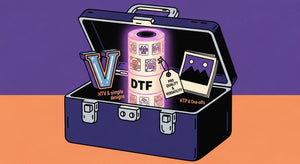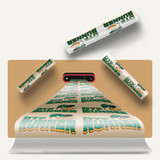Table of Contents
- DTF Transfer Prints
- Preparing for DTF Heat Transfers
- Creating Your Design
- Applying Adhesive Powder
- Transferring the Design to Fabric
- Finishing Touches
- Best Practices for DTF Transfer Prints
- Common Issues and Troubleshooting
- Advanced Tips for DTF Transfer Prints
- Future Trends in DTF Transfer Prints
- DTF Transfer Prints Heat Transfers
Creating high-quality direct-to-film (DTF) heat transfers requires attention to detail, the right materials, and a thorough understanding of the process. DTF transfer prints have become a popular choice in the custom apparel industry due to their versatility, durability, and vibrant colors. This guide will walk you through how to produce high-quality DTF transfer prints.
DTF Transfer Prints
What Are DTF Transfer Prints?
DTF transfer prints involve printing a design onto a special film and then transferring it onto fabric using heat and pressure. This method offers several advantages over traditional printing techniques, including the ability to print on various fabric types and the production of highly detailed, colorful designs.
Why Choose DTF Transfer Prints?
You can choose DTF transfer prints for their versatility, as they can be applied to a wide range of materials, including cotton, polyester, blends, and even leather. Additionally, they offer superior durability, with prints that can withstand multiple washes without fading or cracking. The vibrant and detailed prints achievable with DTF make it an excellent choice for custom apparel.
Preparing for DTF Heat Transfers
Selecting the Right Materials
To create high-quality DTF transfer prints, start by selecting the right materials. Use high-quality PET films specifically designed for DTF printing. Additionally, choose inks that are compatible with your printer and offer vibrant colors and strong adhesion properties.
PET Film
PET film is a very important part of the DTF printing process. Be sure to use a film specifically designed for DTF transfers for the best results. This film should have an extremely flat surface so the ink will spread out evenly and adhere well.
Inks
Choose high-quality, water-based inks that are formulated for DTF printing. These inks should provide vibrant colors and be able to withstand multiple washes without fading. It's important to use inks that are compatible with your printer to avoid any technical issues.

Creating Your Design
Design your DTF transfer prints at high resolution to allow for scaling of the design, proportionately, to the garment. Always use design software that gives you control over color and details, like Adobe Illustrator or CorelDRAW.
High-Resolution Designs
High-resolution designs ensure that your prints are clear and detailed. Aim for a resolution of at least 300 dpi to avoid pixelation and ensure sharp lines and vibrant colors.
Color Management
Color management is key to delivering the correct result. Use color profiles that match your printer and inks to ensure that the colors in your design come out right at the final print.
Printing Your Design
Once your design is ready, it's time to print it onto the PET film. Set up your printer according to the manufacturer's instructions and ensure it is calibrated correctly for DTF printing.
Printer Settings
Adjust your printer settings to optimize the quality of your DTF transfer prints. Use the highest print quality setting available and ensure the ink density is appropriate for your design.
Ink Application
Apply the ink evenly across the film to avoid any inconsistencies in the final print. Ensure that the ink is dry before proceeding to the next step to avoid smudging or blurring.
Applying Adhesive Powder
Choosing the Right Adhesive Powder
The adhesive powder plays a critical role to make sure the design adheres to the fabric. Use a high-quality, fine-grain adhesive powder that is specifically designed for DTF printing.
Applying the Adhesive Powder
After printing the design onto the PET film, apply the adhesive powder evenly across the print. Ensure that the powder covers the entire design without any gaps.
Curing the Adhesive
Cure the adhesive powder by heating it to the recommended temperature. This process melts the powder, allowing it to bond with the ink and create a strong adhesive layer.
Transferring the Design to Fabric
Preparing the Fabric
Remember that you must clean the fabric and iron it before transferring the design. Use a heat press to iron out any imperfections or moisture inside, which will facilitate the transfer process.
Heat Press Settings
Set your heat press to the appropriate temperature, pressure, and time settings for DTF transfer prints. These settings will vary depending on the fabric type and the adhesive powder used.
Transferring the Design
Place the PET film with the printed design onto the fabric and press it using the heat press. Apply even pressure to ensure the design adheres properly to the fabric.
Removing the Film
After the transfer is complete, allow the fabric to cool before removing the PET film. Peel the film away carefully to avoid damaging the print.
Finishing Touches

Curing the Print
After the transfer is complete, the print shall again be cured by applying heat. This step makes sure that the design is attached completely to the fabric and enhances its durability.
Quality Control
Inspect the final product for any imperfections, such as incomplete transfers or color inconsistencies. Make any necessary adjustments to improve the quality of future prints.
Best Practices for DTF Transfer Prints
Regular Maintenance of Equipment
Regular maintenance of your printer and heat press is essential for producing high-quality DTF transfer prints. Clean the equipment regularly and perform any necessary calibrations to ensure optimal performance.
Continuous Learning and Improvement
Stay updated on the latest advancements in DTF printing technology and techniques. Attend workshops, read industry publications, and network with other professionals to continuously improve your skills and knowledge. To capture the spirit of the times is very important.
Experimenting with Different Materials
You can discover more about the many other possibilities of your DTF transfer prints just by experimenting with different kinds of fabrics and materials. It can be unique and give birth to innovative products that will make your business stand out.
Common Issues and Troubleshooting
Ink Smudging
One common issue with DTF transfer prints is ink smudging. This can occur if the ink is not fully dry before applying the adhesive powder or if the heat press temperature is too low. To prevent this, ensure the ink is completely dry before the next step and verify the heat press settings.
Poor Adhesion
Poor adhesion of the DTF transfer prints onto the fabric may cause peeling or cracking. This may be due to a lack of heat or pressure while applying the transfer. Make sure that your heat press is calibrated and that the correct temperature, pressure, and time recommendations have been followed for proper fixation.
Color Inconsistencies
Color inconsistencies can arise due to low-quality inks, low-grade films, or incorrect printer settings. Make sure to have high-quality inks and films, and keep your printer well-adjusted for undeviating color reproduction.

Advanced Tips for DTF Transfer Prints
Layering Techniques
For designs that require multiple colors or complex patterns, consider using layering techniques. Print each color or pattern separately and then layer them during the transfer process to create a cohesive final product.
Custom Blends
Experiment with custom ink blends to achieve unique colors and effects. Mixing different ink colors can result in vibrant and custom hues that are not available in standard ink sets.
Special Effects
Get special effects such as glitter, metallic, or neon inks with DTF transfer prints. These kinds of effects add uniqueness to your designs and make your products stand out.
Customization Options
Offer customization options to your clients, such as personalized text or images. This can increase the value of your products and attract more customers.
Future Trends in DTF Transfer Prints
Eco-Friendly Inks and Films
As sustainability becomes a growing concern, the development of eco-friendly inks and films for DTF printing is on the rise. These materials reduce environmental impact while maintaining high-quality print results.
Improved Equipment
Advancements in DTF printing equipment, such as faster printers and more efficient heat presses, are making the process more accessible and cost-effective. Stay informed about new equipment developments to keep your business competitive.
Integration with Digital Platforms
The integration of DTF printing and digital platforms empowers smooth design and order management. In that respect, this will enable one to have a smooth workflow and satisfied customers.
Expanding Applications
The versatility of DTF printing is leading to its application in various industries beyond apparel, such as home decor, promotional products, and accessories. Explore these new markets to expand your business opportunities.
DTF Transfer Prints Heat Transfers
Attention to detail and the use of proper materials, combined with an insight into the process, is key to making high-quality DTF heat transfers. From this guide, take a step-by-step process to produce vivid, very hard-wearing, versatile DTF transfer prints that are in demand within the ever-desired custom apparel market. Unlock the power of DTF printing to give a facelift to your textile projects with stunning designs that really stand the test of time.






